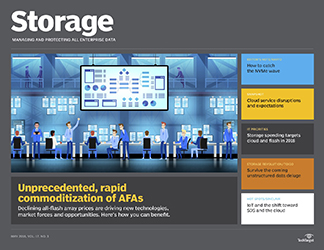PRO+ Premium Content/Storage
Access your Pro+ Content below.
Three trends causing the rapid commoditization of AFA storage

This article is part of the Storage issue of May 2018, Vol. 17, No. 3
The all-flash array market has seen a precipitous price decline over the past few years. AFA prices of $15 or $16 per gigabyte of raw capacity have fallen to $1 or less. Discounts of 80% or more are frequently offered. Storage buyers often believe they're getting a good price from a big-name vendor, but then another vendor comes along at the last minute hungry for a deal and offers a better price. The AFA storage system price war is more surprising when considering how the NAND chip shortage of 2017 and early 2018 caused SSD pricing to increase during this same timeframe. What's the root cause of the rapid commoditization of AFAs? A better understanding requires some context. Skimming the cream High-end products and services have always been subject to commoditization. The first to market in a category typically carries a premium price; that's known as cream skimming. As competition increases, the price gradually declines. These products and services use feature and brand differentiation to maintain higher pricing. But, ...
Features in this issue
-
Three trends causing the rapid commoditization of AFA storage
Advancing technology and changing market forces have shifted the dynamics in the all-flash array market, opening it up to new challengers and benefiting customers.
-
Many enterprises aren't prepared for a cloud service outage
Some businesses have no idea what a cloud outage will cost them and who takes responsibility for restoring data and workloads, the customer or the cloud service provider.
Columns in this issue
-
NVMe technology is but a first step toward bigger things
NVMe is an inevitable move forward for flash technology that begins the transition to storage-class memory and will lead to even more significant storage advances.
-
Cohesity's hyper-converged secondary storage takes on data growth
An out-of-the-box secondary storage strategy to deal with the coming deluge of file and object data promises to overcome scalability, management and capacity limits of NAS.
